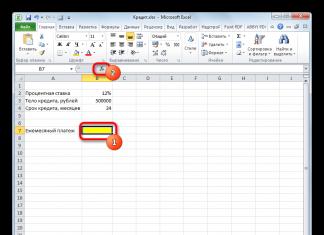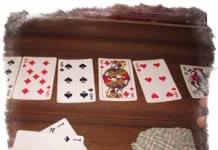Let the function be non-negative and continuous on the interval. Then, according to the geometric meaning of a definite integral, the area of a curvilinear trapezoid bounded above by the graph of this function, below by the axis, on the left and right by straight lines and (see Fig. 2) is calculated by the formula
Example 9. Find the area of a figure bounded by a line ![]() and axis.
and axis.
Solution. Function graph ![]() is a parabola whose branches are directed downward. Let's build it (Fig. 3). To determine the limits of integration, we find the points of intersection of the line (parabola) with the axis (straight line). To do this, we solve the system of equations
is a parabola whose branches are directed downward. Let's build it (Fig. 3). To determine the limits of integration, we find the points of intersection of the line (parabola) with the axis (straight line). To do this, we solve the system of equations

We get: ![]() , where , ; hence, , .
, where , ; hence, , .

Rice. 3
We find the area of the figure using formula (5):
If the function is non-positive and continuous on the segment , then the area of the curvilinear trapezoid bounded below by the graph of this function, above by the axis, on the left and right by straight lines and , is calculated by the formula
 . (6)
. (6)
If the function is continuous on a segment and changes sign at a finite number of points, then the area of the shaded figure (Fig. 4) is equal to the algebraic sum of the corresponding definite integrals:

Rice. 4
Example 10. Calculate the area of the figure bounded by the axis and the graph of the function at .

Rice. 5
Solution. Let's make a drawing (Fig. 5). The required area is the sum of the areas and . Let's find each of these areas. First, we determine the limits of integration by solving the system  We get , . Hence:
We get , . Hence:
 ;
;
 .
.
Thus, the area of the shaded figure is
![]() (sq. units).
(sq. units).

Rice. 6
Finally, let the curvilinear trapezoid be bounded above and below by the graphs of functions continuous on the segment and ,
and on the left and right - straight lines and (Fig. 6). Then its area is calculated by the formula
 . (8)
. (8)
Example 11. Find the area of the figure bounded by the lines and.
Solution. This figure is shown in Fig. 7. Let's calculate its area using formula (8). Solving the system of equations we find, ; hence, , . On the segment we have: . This means that in formula (8) we take as x, and as a quality – . We get:
![]() (sq. units).
(sq. units).
More complex problems of calculating areas are solved by dividing the figure into non-overlapping parts and calculating the area of the entire figure as the sum of the areas of these parts.

Rice. 7
Example 12. Find the area of the figure bounded by the lines , , .
Solution. Let's make a drawing (Fig. 8). This figure can be considered as a curvilinear trapezoid, bounded from below by the axis, to the left and right - by straight lines and, from above - by graphs of functions and. Since the figure is limited from above by the graphs of two functions, to calculate its area, we divide this straight line figure into two parts (1 is the abscissa of the point of intersection of the lines and ). The area of each of these parts is found using formula (4):
 (sq. units);
(sq. units);  (sq. units). Hence:
(sq. units). Hence:
![]() (sq. units).
(sq. units).

Rice. 8
|

Rice. 9
In conclusion, we note that if a curvilinear trapezoid is limited by straight lines and , axis and continuous on the curve (Fig. 9), then its area is found by the formula
Volume of a body of revolution
Let a curvilinear trapezoid, bounded by the graph of a function continuous on a segment, the axis, straight lines and , rotate around the axis (Fig. 10). Then the volume of the resulting body of rotation is calculated by the formula
 . (9)
. (9)
Example 13. Calculate the volume of a body obtained by rotating around the axis of a curvilinear trapezoid bounded by a hyperbola, straight lines, and axis.
Solution. Let's make a drawing (Fig. 11).
From the conditions of the problem it follows that , . From formula (9) we get
 .
.

Rice. 10

Rice. eleven
Volume of a body obtained by rotation around an axis OU curvilinear trapezoid bounded by straight lines y = c And y = d, axis OU and a graph of a function continuous on a segment (Fig. 12), determined by the formula
 . (10)
. (10)
|

Rice. 12
Example 14. Calculate the volume of a body obtained by rotating around an axis OU curvilinear trapezoid bounded by lines X 2 = 4at, y = 4, x = 0 (Fig. 13).
Solution. In accordance with the conditions of the problem, we find the limits of integration: , . Using formula (10) we obtain:

Rice. 13
Arc length of a plane curve
Let the curve given by the equation , where , lie in the plane (Fig. 14).

Rice. 14
Definition. The length of an arc is understood as the limit to which the length of a broken line inscribed in this arc tends, when the number of links of the broken line tends to infinity, and the length of the largest link tends to zero.
If a function and its derivative are continuous on the segment, then the arc length of the curve is calculated by the formula
 . (11)
. (11)
Example 15. Calculate the arc length of the curve enclosed between the points for which ![]() .
.
Solution. From the problem conditions we have ![]() . Using formula (11) we obtain:
. Using formula (11) we obtain:
 .
.
4. Improper integrals
with infinite limits of integration
When introducing the concept of a definite integral, it was assumed that the following two conditions were satisfied:
a) limits of integration A and are finite;
b) the integrand is bounded on the interval.
If at least one of these conditions is not satisfied, then the integral is called not your own.
Let us first consider improper integrals with infinite limits of integration.
Definition. Let the function be defined and continuous on the interval, then and unlimited on the right (Fig. 15).
If the improper integral converges, then this area is finite; if the improper integral diverges, then this area is infinite.

Rice. 15
An improper integral with an infinite lower limit of integration is defined similarly:
 . (13)
. (13)
This integral converges if the limit on the right side of equality (13) exists and is finite; otherwise the integral is called divergent.
An improper integral with two infinite limits of integration is defined as follows:
 , (14)
, (14)
where c is any point of the interval. The integral converges only if both integrals on the right side of equality (14) converge.
;G)  = [select a complete square in the denominator: ] =
= [select a complete square in the denominator: ] =  [replacement:
[replacement:
] = 
This means that the improper integral converges and its value is equal to .
Definite integral. How to calculate the area of a figure
Let's move on to consider applications of integral calculus. In this lesson we will analyze the typical and most common task – how to use a definite integral to calculate the area of a plane figure. Finally, those who are looking for meaning in higher mathematics - may they find it. You never know. In real life, you will have to approximate a dacha plot using elementary functions and find its area using a definite integral.
To successfully master the material, you must:
1) Understand the indefinite integral at least at an intermediate level. Thus, dummies should first read the lesson Not.
2) Be able to apply the Newton-Leibniz formula and calculate the definite integral. You can establish warm friendly relations with certain integrals on the page Definite integral. Examples of solutions.
In fact, in order to find the area of a figure, you don’t need that much knowledge of the indefinite and definite integral. The task “calculate the area using a definite integral” always involves constructing a drawing, so your knowledge and drawing skills will be a much more pressing issue. In this regard, it is useful to refresh your memory of the graphs of basic elementary functions, and, at a minimum, to be able to construct a straight line, parabola and hyperbola. This can be done (for many, it is necessary) with the help of methodological material and an article on geometric transformations of graphs.
Actually, everyone has been familiar with the task of finding the area using a definite integral since school, and we will not go much further than the school curriculum. This article might not have existed at all, but the fact is that the problem occurs in 99 cases out of 100, when a student suffers from a hated school and enthusiastically masters a course in higher mathematics.
The materials of this workshop are presented simply, in detail and with a minimum of theory.
Let's start with a curved trapezoid.
Curvilinear trapezoid is a flat figure bounded by an axis, straight lines, and the graph of a function continuous on an interval that does not change sign on this interval. Let this figure be located not less x-axis:

Then the area of a curvilinear trapezoid is numerically equal to a definite integral. Any definite integral (that exists) has a very good geometric meaning. At the lesson Definite integral. Examples of solutions I said that a definite integral is a number. And now it’s time to state another useful fact. From the point of view of geometry, the definite integral is AREA.
That is, the definite integral (if it exists) geometrically corresponds to the area of a certain figure. For example, consider the definite integral. The integrand defines a curve on the plane located above the axis (those who wish can make a drawing), and the definite integral itself is numerically equal to the area of the corresponding curvilinear trapezoid.
Example 1
This is a typical assignment statement. The first and most important point in the decision is the construction of a drawing. Moreover, the drawing must be constructed RIGHT.
When constructing a drawing, I recommend the following order: at first it is better to construct all straight lines (if they exist) and only Then– parabolas, hyperbolas, graphs of other functions. It is more profitable to build graphs of functions point by point, the point-by-point construction technique can be found in the reference material Graphs and properties of elementary functions. There you can also find very useful material for our lesson - how to quickly build a parabola.
In this problem, the solution might look like this.
Let's draw the drawing (note that the equation defines the axis):

I will not shade the curved trapezoid; it is obvious here what area we are talking about. The solution continues like this:
On the segment, the graph of the function is located above the axis, That's why:
Answer:
Who has difficulties with calculating the definite integral and applying the Newton-Leibniz formula  , refer to the lecture Definite integral. Examples of solutions.
, refer to the lecture Definite integral. Examples of solutions.
After the task is completed, it is always useful to look at the drawing and figure out whether the answer is real. In this case, we count the number of cells in the drawing “by eye” - well, there will be about 9, which seems to be true. It is absolutely clear that if we got, say, the answer: 20 square units, then it is obvious that a mistake was made somewhere - 20 cells obviously do not fit into the figure in question, at most a dozen. If the answer is negative, then the task was also solved incorrectly.
Example 2
Calculate the area of a figure bounded by lines , , and axis
This is an example for you to solve on your own. Full solution and answer at the end of the lesson.
What to do if the curved trapezoid is located under the axle?
Example 3
Calculate the area of the figure bounded by lines and coordinate axes.
Solution: Let's make a drawing: 
If a curved trapezoid is located under the axle(or at least not higher given axis), then its area can be found using the formula:
In this case: 
Attention! The two types of tasks should not be confused:
1) If you are asked to solve simply a definite integral without any geometric meaning, then it may be negative.
2) If you are asked to find the area of a figure using a definite integral, then the area is always positive! That is why the minus appears in the formula just discussed.
In practice, most often the figure is located in both the upper and lower half-plane, and therefore, from the simplest school problems we move on to more meaningful examples.
Example 4
Find the area of a plane figure bounded by the lines , .
Solution: First you need to complete the drawing. Generally speaking, when constructing a drawing in area problems, we are most interested in the points of intersection of lines. Let's find the intersection points of the parabola and the straight line. This can be done in two ways. The first method is analytical. We solve the equation:
This means that the lower limit of integration is , the upper limit of integration is .
If possible, it is better not to use this method..
It is much more profitable and faster to construct lines point by point, and the limits of integration become clear “by themselves.” The point-by-point construction technique for various graphs is discussed in detail in the help Graphs and properties of elementary functions. Nevertheless, the analytical method of finding limits still sometimes has to be used if, for example, the graph is large enough, or the detailed construction did not reveal the limits of integration (they can be fractional or irrational). And we will also consider such an example.
Let's return to our task: it is more rational to first construct a straight line and only then a parabola. Let's make the drawing: 
I repeat that when constructing pointwise, the limits of integration are most often found out “automatically”.
And now the working formula: If there is some continuous function on the segment greater than or equal to some continuous function , then the area of the figure bounded by the graphs of these functions and the lines , , can be found using the formula: 
Here you no longer need to think about where the figure is located - above the axis or below the axis, and, roughly speaking, it matters which graph is HIGHER(relative to another graph), and which one is BELOW.
In the example under consideration, it is obvious that on the segment the parabola is located above the straight line, and therefore it is necessary to subtract from
The completed solution might look like this:
The desired figure is limited by a parabola above and a straight line below.
On the segment, according to the corresponding formula:
Answer:
In fact, the school formula for the area of a curvilinear trapezoid in the lower half-plane (see simple example No. 3) is a special case of the formula  . Since the axis is specified by the equation, and the graph of the function is located not higher axes, then
. Since the axis is specified by the equation, and the graph of the function is located not higher axes, then 
And now a couple of examples for your own solution
Example 5
Example 6
Find the area of the figure bounded by the lines , .
When solving problems involving calculating area using a definite integral, a funny incident sometimes happens. The drawing was done correctly, the calculations were correct, but due to carelessness... the area of the wrong figure was found, this is exactly how your humble servant screwed up several times. Here is a real life case:
Example 7
Calculate the area of the figure bounded by the lines , , , .
Solution: First, let's make a drawing: 
...Eh, the drawing came out crap, but everything seems to be legible.
The figure whose area we need to find is shaded blue(look carefully at the condition - how the figure is limited!). But in practice, due to inattention, a “glitch” often occurs that you need to find the area of a figure that is shaded in green!
This example is also useful in that it calculates the area of a figure using two definite integrals. Really:
1) On the segment above the axis there is a graph of a straight line;
2) On the segment above the axis there is a graph of a hyperbola.
It is quite obvious that the areas can (and should) be added, therefore:

Answer:
Let's move on to another meaningful task.
Example 8
Calculate the area of a figure bounded by lines,
Let’s present the equations in “school” form and make a point-by-point drawing: 
From the drawing it is clear that our upper limit is “good”: .
But what is the lower limit?! It is clear that this is not an integer, but what is it? May be ? But where is the guarantee that the drawing is made with perfect accuracy, it may well turn out that... Or the root. What if we built the graph incorrectly?
In such cases, you have to spend additional time and clarify the limits of integration analytically.
Let's find the intersection points of a straight line and a parabola.
To do this, we solve the equation: 

,
Really, .
The further solution is trivial, the main thing is not to get confused in substitutions and signs; the calculations here are not the simplest.
On the segment ![]() , according to the corresponding formula:
, according to the corresponding formula: 
Answer: ![]()
Well, to conclude the lesson, let’s look at two more difficult tasks.
Example 9
Calculate the area of the figure bounded by the lines , ,
Solution: Let's depict this figure in the drawing. 
Damn, I forgot to sign the schedule, and, sorry, I didn’t want to redo the picture. Not a drawing day, in short, today is the day =)
For point-by-point construction, it is necessary to know the appearance of a sinusoid (and in general it is useful to know graphs of all elementary functions), as well as some sine values, they can be found in trigonometric table. In some cases (as in this case), it is possible to construct a schematic drawing, on which the graphs and limits of integration should be fundamentally correctly displayed.
There are no problems with the limits of integration here; they follow directly from the condition: “x” changes from zero to “pi”. Let's make a further decision:
On the segment, the graph of the function is located above the axis, therefore:
Any definite integral (that exists) has a very good geometric meaning. In class I said that a definite integral is a number. And now it’s time to state another useful fact. From the point of view of geometry, the definite integral is AREA.
That is, the definite integral (if it exists) geometrically corresponds to the area of a certain figure. For example, consider the definite integral. The integrand defines a certain curve on the plane (it can always be drawn if desired), and the definite integral itself is numerically equal to the area of the corresponding curvilinear trapezoid.
Example 1
This is a typical assignment statement. The first and most important point in the decision is the construction of a drawing. Moreover, the drawing must be constructed RIGHT.
When constructing a drawing, I recommend the following order: at first it is better to construct all straight lines (if they exist) and only Then– parabolas, hyperbolas, graphs of other functions. It is more profitable to build graphs of functions point by point, the point-by-point construction technique can be found in the reference material.
There you can also find very useful material for our lesson - how to quickly build a parabola.
In this problem, the solution might look like this.
Let's draw the drawing (note that the equation defines the axis):

I will not shade the curved trapezoid; it is obvious here what area we are talking about. The solution continues like this:
On the segment, the graph of the function is located above the axis, That's why:
Answer:
Who has difficulties with calculating the definite integral and applying the Newton-Leibniz formula  , refer to the lecture Definite integral. Examples of solutions.
, refer to the lecture Definite integral. Examples of solutions.
After the task is completed, it is always useful to look at the drawing and figure out whether the answer is real. In this case, we count the number of cells in the drawing “by eye” - well, there will be about 9, which seems to be true. It is absolutely clear that if we got, say, the answer: 20 square units, then it is obvious that a mistake was made somewhere - 20 cells obviously do not fit into the figure in question, at most a dozen. If the answer is negative, then the task was also solved incorrectly.
Example 2
Calculate the area of a figure bounded by lines , , and axis
This is an example for you to solve on your own. Full solution and answer at the end of the lesson.
What to do if the curved trapezoid is located under the axle?
Example 3
Calculate the area of the figure bounded by lines and coordinate axes.
Solution: Let's make a drawing: 
If a curved trapezoid completely located under the axis, then its area can be found using the formula:
In this case: 
Attention! The two types of tasks should not be confused:
1) If you are asked to solve simply a definite integral without any geometric meaning, then it may be negative.
2) If you are asked to find the area of a figure using a definite integral, then the area is always positive! That is why the minus appears in the formula just discussed.
In practice, most often the figure is located in both the upper and lower half-plane, and therefore, from the simplest school problems we move on to more meaningful examples.
Example 4
Find the area of a plane figure bounded by the lines , .
Solution: First you need to make a drawing. Generally speaking, when constructing a drawing in area problems, we are most interested in the points of intersection of lines. Let's find the intersection points of the parabola and the straight line. This can be done in two ways. The first method is analytical. We solve the equation:
This means that the lower limit of integration is , the upper limit of integration is .
It is better not to use this method, if possible.
It is much more profitable and faster to construct lines point by point, and the limits of integration become clear “by themselves.” The point-by-point construction technique for various graphs is discussed in detail in the help Graphs and properties of elementary functions. Nevertheless, the analytical method of finding limits still sometimes has to be used if, for example, the graph is large enough, or the detailed construction did not reveal the limits of integration (they can be fractional or irrational). And we will also consider such an example.
Let's return to our task: it is more rational to first construct a straight line and only then a parabola. Let's make the drawing: 
I repeat that when constructing pointwise, the limits of integration are most often found out “automatically”.
And now the working formula: If on a segment there is some continuous function greater than or equal to some continuous function, then the area of the corresponding figure can be found using the formula:

Here you no longer need to think about where the figure is located - above the axis or below the axis, and, roughly speaking, it matters which graph is HIGHER(relative to another graph), and which one is BELOW.
In the example under consideration, it is obvious that on the segment the parabola is located above the straight line, and therefore it is necessary to subtract from
The completed solution might look like this:
The desired figure is limited by a parabola above and a straight line below.
On the segment, according to the corresponding formula:
Answer:
In fact, the school formula for the area of a curvilinear trapezoid in the lower half-plane (see simple example No. 3) is a special case of the formula  . Since the axis is specified by the equation and the graph of the function is located below the axis, then
. Since the axis is specified by the equation and the graph of the function is located below the axis, then 
And now a couple of examples for your own solution
Example 5
Example 6
Find the area of the figure bounded by the lines , .
When solving problems involving calculating area using a definite integral, a funny incident sometimes happens. The drawing was done correctly, the calculations were correct, but due to carelessness... the area of the wrong figure was found, this is exactly how your humble servant screwed up several times. Here is a real life case:
Example 7
Calculate the area of the figure bounded by the lines , , , .
First let's make a drawing: 
The figure whose area we need to find is shaded blue(look carefully at the condition - how the figure is limited!). But in practice, due to inattention, it often arises that you need to find the area of a figure that is shaded in green!
This example is also useful because it calculates the area of a figure using two definite integrals. Really:
1) On the segment above the axis there is a graph of a straight line;
2) On the segment above the axis there is a graph of a hyperbola.
It is quite obvious that the areas can (and should) be added, therefore:

Answer:
Example 8
Calculate the area of a figure bounded by lines,
Let’s present the equations in “school” form and make a point-by-point drawing: 
From the drawing it is clear that our upper limit is “good”: .
But what is the lower limit?! It is clear that this is not an integer, but what is it? May be ? But where is the guarantee that the drawing is made with perfect accuracy, it may well turn out that... Or the root. What if we built the graph incorrectly?
In such cases, you have to spend additional time and clarify the limits of integration analytically.
Let's find the intersection points of a straight line and a parabola.
To do this, we solve the equation: 

Hence, .
The further solution is trivial, the main thing is not to get confused in substitutions and signs; the calculations here are not the simplest.
On the segment ![]() , according to the corresponding formula:
, according to the corresponding formula: 
Answer: ![]()
Well, to conclude the lesson, let’s look at two more difficult tasks.
Example 9
Calculate the area of the figure bounded by the lines , ,
Solution: Let's depict this figure in the drawing. 
To construct a point-by-point drawing, you need to know the appearance of a sinusoid (and in general it’s useful to know graphs of all elementary functions), as well as some sine values, they can be found in trigonometric table. In some cases (as in this case), it is possible to construct a schematic drawing, on which the graphs and limits of integration should be fundamentally correctly displayed.
There are no problems with the limits of integration here; they follow directly from the condition: “x” changes from zero to “pi”. Let's make a further decision:
On the segment, the graph of the function is located above the axis, therefore:
(1) You can see how sines and cosines are integrated in odd powers in the lesson Integrals of trigonometric functions. This is a typical technique, we pinch off one sinus.
(2) We use the main trigonometric identity in the form ![]()
(3) Let’s change the variable , then:
New areas of integration:
Anyone who is really bad with substitutions, please take a lesson. Substitution method in indefinite integral. For those who do not quite understand the replacement algorithm in a definite integral, visit the page Definite integral. Examples of solutions.
Introduction
Finding the derivative f" (x) or the differential df=f" (x) dx of the function f(x) is the main problem of differential calculus. In integral calculus, the inverse problem is solved: given a function f(x), it is required to find a function F(x) such that F" (x)=f(x) or F(x)=F" (x) dx=f(x )dx. Thus, the main task of integral calculus is to restore the function F(x) from the known derivative (differential) of this function. Integral calculus has numerous applications in geometry, mechanics, physics and technology. It gives a general method for finding areas, volumes, centers of gravity, etc.
The course of mathematical analysis contains a variety of material, however, one of its central sections is the definite integral. Integrating many types of functions is sometimes one of the most difficult problems in mathematical analysis.
The calculation of the definite integral is not only of theoretical interest. Sometimes problems related to practical human activity come down to its calculation.
Also, the concept of a definite integral is widely used in physics.
Finding the area of a curved trapezoid
A curved trapezoid is a figure located in a rectangular coordinate system and limited by the x-axis and straight lines. x = a And x = b and a curve, and is non-negative on the segment. The approximate area of a curved trapezoid can be found as follows:
1. divide the x-axis segment into n equal segments;
2. draw segments perpendicular to the abscissa axis through the division points until they intersect with the curve;
3. replace the resulting columns with rectangles with a base and height equal to the function value f at the left end of each segment;
4. find the sum of the areas of these rectangles.
But you can find the curvilinear area differently: using the Newton-Leibniz formula. To prove the formula that bears their names, we prove that the area of a curvilinear trapezoid is equal to, where is any of the antiderivatives of the function whose graph bounds the curvilinear trapezoid.
Calculation of the area of a curved trapezoid is written as follows:
1. any of the antiderivatives of the function is found.

2. is recorded. - This is the Newton-Leibniz formula.
Finding the area of a curved sector
Let's look at the curve? = ? (?) in the polar coordinate system, where? (?) - continuous and non-negative on [?; ?] function. A figure bounded by a curve? (?) and rays? = ?, ? = ?, is called a curvilinear sector. The area of the curvilinear sector is equal to
Finding the Arc Length of a Curve
Rectangular coordinates
Let a plane curve AB be given in rectangular coordinates, the equation of which is y = f(x), where a? x? b. (Figure 2)
The length of the arc AB is understood as the limit to which the length of a broken line inscribed in this arc tends when the number of links of the broken line increases indefinitely, and the length of its largest link tends to zero.
Let's apply scheme I (sum method).
Using points X = a, X, …, X = b (X ? X? … ? X) we divide the segment into n parts. Let these points correspond to the points M = A, M, …, M = B on the curve AB. Let us draw chords MM, MM, …, MM, the lengths of which will be denoted by ?L, ?L, …, ?L, respectively.

We obtain a broken line MMM ... MM, the length of which is equal to L = ?L+ ?L+ ... + ?L = ?L.
The length of a chord (or a broken line link) ?L can be found using the Pythagorean theorem from a triangle with legs ?X and ?Y:
L = , where?X = X - X, ?Y = f(X) - f(X).
By Lagrange's theorem on the finite increment of a function
Y = (C) ?X, where C (X, X).
and the length of the entire broken line MMM...MM is equal to
The length of the curve AB, by definition, is equal to
Note that when ?L 0 also ?X 0 (?L = and therefore | ?X |< ?L). Функция непрерывна на отрезке , так как, по условию, непрерывна функция f (X). Следовательно, существует предел интегральной суммы L=?L= , кода max ?X 0:
Thus L = dx.
Example: Find the circumference of a circle of radius R. (Figure 3)

Shall we find it? part of its length from point (0; R) to point (R; 0). Because







 Back forward
Back forward
Attention! Slide previews are for informational purposes only and may not represent all the features of the presentation. If you are interested in this work, please download the full version.
Keywords: integral, curvilinear trapezoid, area of figures bounded by lilies
Equipment: marker board, computer, multimedia projector
Lesson type: lesson-lecture
Lesson Objectives:
- educational: to create a culture of mental work, create a situation of success for each student, and create positive motivation for learning; develop the ability to speak and listen to others.
- developing: formation of independent thinking of the student in applying knowledge in various situations, the ability to analyze and draw conclusions, development of logic, development of the ability to correctly pose questions and find answers to them. Improving the formation of computational skills, developing students’ thinking in the course of completing proposed tasks, developing an algorithmic culture.
- educational: to form concepts about a curvilinear trapezoid, about an integral, to master the skills of calculating the areas of plane figures
Teaching Method: explanatory and illustrative.
During the classes
In previous classes we learned to calculate the areas of figures whose boundaries are broken lines. In mathematics, there are methods that allow you to calculate the areas of figures bounded by curves. Such figures are called curvilinear trapezoids, and their area is calculated using antiderivatives.
Curvilinear trapezoid ( slide 1)
A curved trapezoid is a figure bounded by the graph of a function, ( sh.m.), straight x = a And x = b and x-axis
Various types of curved trapezoids ( slide 2)
We consider various types of curvilinear trapezoids and notice: one of the straight lines is degenerate to a point, the role of the limiting function is played by the straight line
Area of a curved trapezoid (slide 3)
Let us fix the left end of the interval A, and the right one X we will change, i.e., we move the right wall of the curvilinear trapezoid and get a changing figure. The area of a variable curvilinear trapezoid bounded by the graph of the function is an antiderivative F for function f
And on the segment [ a; b] area of a curvilinear trapezoid formed by the function f, is equal to the increment of the antiderivative of this function:
Exercise 1:
Find the area of a curvilinear trapezoid bounded by the graph of the function: f(x) = x 2 and straight y = 0, x = 1, x = 2.

Solution: ( according to the algorithm slide 3)
Let's draw a graph of the function and lines
Let's find one of the antiderivatives of the function f(x) = x 2 :
Slide self-test
Integral
Consider a curvilinear trapezoid defined by the function f on the segment [ a; b]. Let's break this segment into several parts. The area of the entire trapezoid will be divided into the sum of the areas of smaller curved trapezoids. ( slide 5). Each such trapezoid can be approximately considered a rectangle. The sum of the areas of these rectangles gives an approximate idea of the entire area of the curved trapezoid. The smaller we divide the segment [ a; b], the more accurately we calculate the area.
Let us write these arguments in the form of formulas.
Divide the segment [ a; b] into n parts by dots x 0 = a, x1,…, xn = b. Length k- th denote by xk = xk – xk-1. Let's make a sum
Geometrically, this sum represents the area of the figure shaded in the figure ( sh.m.)
Sums of the form are called integral sums for the function f. (sh.m.)
Integral sums give an approximate value of the area. The exact value is obtained by passing to the limit. Let's imagine that we are refining the partition of the segment [ a; b] so that the lengths of all small segments tend to zero. Then the area of the composed figure will approach the area of the curved trapezoid. We can say that the area of a curved trapezoid is equal to the limit of integral sums, Sc.t. (sh.m.) or integral, i.e.,
Definition:
Integral of a function f(x) from a before b called the limit of integral sums
= (sh.m.)
Newton-Leibniz formula.
We remember that the limit of integral sums is equal to the area of a curvilinear trapezoid, which means we can write:
Sc.t. = (sh.m.)
On the other hand, the area of a curved trapezoid is calculated using the formula
S k.t. (sh.m.)
Comparing these formulas, we get:
= (sh.m.)This equality is called the Newton-Leibniz formula.
For ease of calculation, the formula is written as:
= = (sh.m.)Tasks: (sh.m.)
1. Calculate the integral using the Newton-Leibniz formula: ( check on slide 5)
2. Compose integrals according to the drawing ( check on slide 6)
3. Find the area of the figure bounded by the lines: y = x 3, y = 0, x = 1, x = 2. ( Slide 7)
Finding the areas of plane figures ( slide 8)
How to find the area of figures that are not curved trapezoids?
Let two functions be given, the graphs of which you see on the slide . (sh.m.) Find the area of the shaded figure . (sh.m.). Is the figure in question a curved trapezoid? How can you find its area using the property of additivity of area? Consider two curved trapezoids and subtract the area of the other from the area of one of them ( sh.m.)
Let's create an algorithm for finding the area using animation on a slide:
- Graph functions
- Project the intersection points of the graphs onto the x-axis
- Shade the figure obtained when the graphs intersect
- Find curvilinear trapezoids whose intersection or union is the given figure.
- Calculate the area of each of them
- Find the difference or sum of areas
Oral task: How to obtain the area of a shaded figure (tell using animation, slide 8 and 9)
Homework: Work through the notes, No. 353 (a), No. 364 (a).
Bibliography
- Algebra and the beginnings of analysis: a textbook for grades 9-11 of evening (shift) school / ed. G.D. Glaser. - M: Enlightenment, 1983.
- Bashmakov M.I. Algebra and the beginnings of analysis: a textbook for 10-11 grades of secondary school / Bashmakov M.I. - M: Enlightenment, 1991.
- Bashmakov M.I. Mathematics: textbook for institutions beginning. and Wednesday prof. education / M.I. Bashmakov. - M: Academy, 2010.
- Kolmogorov A.N. Algebra and beginnings of analysis: textbook for grades 10-11. educational institutions / A.N. Kolmogorov. - M: Education, 2010.
- Ostrovsky S.L. How to make a presentation for a lesson?/ S.L. Ostrovsky. – M.: First of September, 2010.


























